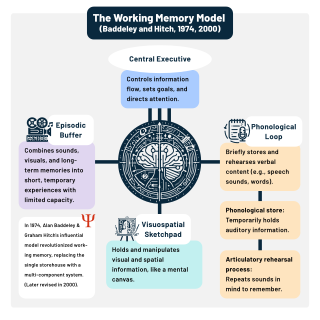Related Research Articles

Working memory is a cognitive system with a limited capacity that can hold information temporarily. It is important for reasoning and the guidance of decision-making and behavior. Working memory is often used synonymously with short-term memory, but some theorists consider the two forms of memory distinct, assuming that working memory allows for the manipulation of stored information, whereas short-term memory only refers to the short-term storage of information. Working memory is a theoretical concept central to cognitive psychology, neuropsychology, and neuroscience.
Visual thinking, also called visual or spatial learning or picture thinking, is the phenomenon of thinking through visual processing. Visual thinking has been described as seeing words as a series of pictures. It is common in approximately 60–65% of the general population. "Real picture thinkers", those who use visual thinking almost to the exclusion of other kinds of thinking, make up a smaller percentage of the population. Research by child development theorist Linda Kreger Silverman suggests that less than 30% of the population strongly uses visual/spatial thinking, another 45% uses both visual/spatial thinking and thinking in the form of words, and 25% thinks exclusively in words. According to Kreger Silverman, of the 30% of the general population who use visual/spatial thinking, only a small percentage would use this style over and above all other forms of thinking, and can be said to be true "picture thinkers".

A child prodigy is a person under the age of ten who produces meaningful work in some domain at the level of an adult expert. The term is also applied more broadly to describe young people who are extraordinarily talented in some field.

Neuropsychological tests are specifically designed tasks that are used to measure a psychological function known to be linked to a particular brain structure or pathway. Tests are used for research into brain function and in a clinical setting for the diagnosis of deficits. They usually involve the systematic administration of clearly defined procedures in a formal environment. Neuropsychological tests are typically administered to a single person working with an examiner in a quiet office environment, free from distractions. As such, it can be argued that neuropsychological tests at times offer an estimate of a person's peak level of cognitive performance. Neuropsychological tests are a core component of the process of conducting neuropsychological assessment, along with personal, interpersonal and contextual factors.
Dyscalculia is a disability resulting in difficulty learning or comprehending arithmetic, such as difficulty in understanding numbers, learning how to manipulate numbers, performing mathematical calculations, and learning facts in mathematics. It is sometimes colloquially referred to as "math dyslexia", though this analogy can be misleading as they are distinct syndromes.

In cognitive psychology and neuroscience, spatial memory is a form of memory responsible for the recording and recovery of information needed to plan a course to a location and to recall the location of an object or the occurrence of an event. Spatial memory is necessary for orientation in space. Spatial memory can also be divided into egocentric and allocentric spatial memory. A person's spatial memory is required to navigate around a familiar city. A rat's spatial memory is needed to learn the location of food at the end of a maze. In both humans and animals, spatial memories are summarized as a cognitive map.

Baddeley's model of working memory is a model of human memory proposed by Alan Baddeley and Graham Hitch in 1974, in an attempt to present a more accurate model of primary memory. Working memory splits primary memory into multiple components, rather than considering it to be a single, unified construct.

Visual memory describes the relationship between perceptual processing and the encoding, storage and retrieval of the resulting neural representations. Visual memory occurs over a broad time range spanning from eye movements to years in order to visually navigate to a previously visited location. Visual memory is a form of memory which preserves some characteristics of our senses pertaining to visual experience. We are able to place in memory visual information which resembles objects, places, animals or people in a mental image. The experience of visual memory is also referred to as the mind's eye through which we can retrieve from our memory a mental image of original objects, places, animals or people. Visual memory is one of several cognitive systems, which are all interconnected parts that combine to form the human memory. Types of palinopsia, the persistence or recurrence of a visual image after the stimulus has been removed, is a dysfunction of visual memory.
Cerebral atrophy is a common feature of many of the diseases that affect the brain. Atrophy of any tissue means a decrement in the size of the cell, which can be due to progressive loss of cytoplasmic proteins. In brain tissue, atrophy describes a loss of neurons and the connections between them. Brain atrophy can be classified into two main categories: generalized and focal atrophy. Generalized atrophy occurs across the entire brain whereas focal atrophy affects cells in a specific location. If the cerebral hemispheres are affected, conscious thought and voluntary processes may be impaired.
The two-streams hypothesis is a model of the neural processing of vision as well as hearing. The hypothesis, given its initial characterisation in a paper by David Milner and Melvyn A. Goodale in 1992, argues that humans possess two distinct visual systems. Recently there seems to be evidence of two distinct auditory systems as well. As visual information exits the occipital lobe, and as sound leaves the phonological network, it follows two main pathways, or "streams". The ventral stream leads to the temporal lobe, which is involved with object and visual identification and recognition. The dorsal stream leads to the parietal lobe, which is involved with processing the object's spatial location relative to the viewer and with speech repetition.
Information processing theory is the approach to the study of cognitive development evolved out of the American experimental tradition in psychology. Developmental psychologists who adopt the information processing perspective account for mental development in terms of maturational changes in basic components of a child's mind. The theory is based on the idea that humans process the information they receive, rather than merely responding to stimuli. This perspective uses an analogy to consider how the mind works like a computer. In this way, the mind functions like a biological computer responsible for analyzing information from the environment. According to the standard information-processing model for mental development, the mind's machinery includes attention mechanisms for bringing information in, working memory for actively manipulating information, and long-term memory for passively holding information so that it can be used in the future. This theory addresses how as children grow, their brains likewise mature, leading to advances in their ability to process and respond to the information they received through their senses. The theory emphasizes a continuous pattern of development, in contrast with cognitive-developmental theorists such as Jean Piaget's theory of cognitive development that thought development occurs in stages at a time.

Age-related memory loss, sometimes described as "normal aging", is qualitatively different from memory loss associated with types of dementia such as Alzheimer's disease, and is believed to have a different brain mechanism.
Elizabeth Kerr Warrington FRS is a British neuropsychologist specialised in the study of dementia. She holds a PhD in Psychology visual processing and is now an emeritus professor of clinical neuropsychology at the University College London. She formerly worked as the Head of the Department of Neuropsychology at the National Hospital for Neurology and Neurosurgery where she is also a member of the Dementia Research Centre. She was made a Fellow of the Royal Society in 1986.
The neuroanatomy of memory encompasses a wide variety of anatomical structures in the brain.
The effects of sleep deprivation on cognitive performance are a broad range of impairments resulting from inadequate sleep, impacting attention, executive function and memory. An estimated 20% of adults or more have some form of sleep deprivation. It may come with insomnia or major depressive disorder, or indicate other mental disorders. The consequences can negatively affect the health, cognition, energy level and mood of a person and anyone around. It increases the risk of human error, especially with technology.
Constructional apraxia is a neurological disorder in which people are unable to perform tasks or movements even though they understand the task, are willing to complete it, and have the physical ability to perform the movements. It is characterized by an inability or difficulty to build, assemble, or draw objects. Constructional apraxia may be caused by lesions in the parietal lobe following stroke or it may serve as an indicator for Alzheimer's disease.
In cognitive psychology, spatial cognition is the acquisition, organization, utilization, and revision of knowledge about spatial environments. It is most about how animals, including humans, behave within space and the knowledge they built around it, rather than space itself. These capabilities enable individuals to manage basic and high-level cognitive tasks in everyday life. Numerous disciplines work together to understand spatial cognition in different species, especially in humans. Thereby, spatial cognition studies also have helped to link cognitive psychology and neuroscience. Scientists in both fields work together to figure out what role spatial cognition plays in the brain as well as to determine the surrounding neurobiological infrastructure.

Many memory impairments exist as a result from or cause of eating disorders. Eating disorders (EDs) are characterized by abnormal and disturbed eating patterns that affect the lives of the individuals who worry about their weight to the extreme. These abnormal eating patterns involve either inadequate or excessive food intake, affecting the individual's physical and mental health.
The Addenbrooke's Cognitive Examination (ACE) and its subsequent versions are neuropsychological tests used to identify cognitive impairment in conditions such as dementia.

Spatial ability or visuo-spatial ability is the capacity to understand, reason, and remember the visual and spatial relations among objects or space.